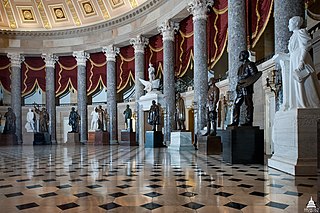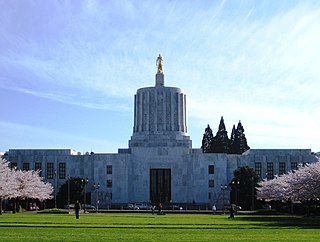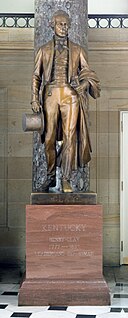
The National Statuary Hall is a chamber in the United States Capitol devoted to sculptures of prominent Americans. The hall, also known as the Old Hall of the House, is a large, two-story, semicircular room with a second story gallery along the curved perimeter. It is located immediately south of the Rotunda. The meeting place of the U.S. House of Representatives for nearly 50 years (1807–1857), after a few years of disuse in 1864 it was repurposed as a statuary hall; this is when the National Statuary Hall Collection was established. By 1933 the collection had outgrown this single room, and a number of statues are placed elsewhere within the Capitol.

Alexander Phimister Proctor was an American sculptor with the contemporary reputation as one of the nation's foremost animaliers.

The Oregon State Capitol is the building housing the state legislature and the offices of the governor, secretary of state, and treasurer of the U.S. state of Oregon. It is located in the state capital, Salem. Constructed from 1936 to 1938 and expanded in 1977, the current building is the third to house the Oregon state government in Salem. The first two capitols in Salem were destroyed by fire, one in 1855 and the other in 1935.

Oregon Pioneer, also known as Gold Man, is an eight-and-a-half ton bronze sculpture with gold leaf finish that sits atop the Oregon State Capitol in Salem, Oregon, United States. Created by Ulric Ellerhusen, the statue is a 22 ft (7 m)-tall hollow sculpture. The gilded piece was installed atop the building in 1938 when a new capitol was built.

The Circuit Rider is a bronze sculpture by Alexander Phimister Proctor, located in Capitol Park, east of the Oregon State Capitol in Salem, Oregon, in the United States.

Jason Lee, also known as Reverend Jason Lee, is an outdoor bronze sculpture of Jason Lee, located in Salem, Oregon, United States. It was designed by Alexander Phimister Proctor, who died in 1950 when only the work's model was finished. His son Gifford MacGregor Proctor completed the sculpture between 1950 and 1953. The one installed on the grounds of the Oregon State Capitol is a duplicate of a bronze statue unveiled in the United States Capitol in 1952.

Edmund Kirby Smith is a bronze sculpture commemorating the United States Army officer of the same name by C. Adrian Pillars, installed in the United States Capitol Visitor Center as part of the National Statuary Hall Collection. The statue was gifted by the state of Florida in 1922.

Breyman Fountain, also known as the Breyman Brothers Fountain and Breyman Horse Trough, is an outdoor fountain by an unknown sculptor, installed in Willson Park, on the grounds of the Oregon State Capitol, in Salem, Oregon, United States.

Sakakawea is a monumental sized bronze sculpture created by Leonard Crunelle. It was dedicated on October 13, 1914 and stands on the grounds of the North Dakota State Capitol in Bismarck, North Dakota.

Edward Lewis Bartlett is a bronze sculpture depicting the American politician of the same name by Felix W. de Weldon, installed at the United States Capitol in Washington, D.C., as part of the National Statuary Hall Collection. The statue was gifted by the U.S. state of Alaska in 1971.

William Borah is a bronze sculpture depicting the American politician of the same name by Bryant Baker, installed in the United States Capitol Visitor Center's Emancipation Room, in Washington, D.C., as part of the National Statuary Hall Collection. The statue was gifted by the U.S. state of Idaho in 1947.

James Paul Clarke is a marble sculpture depicting the American politician of the same name by Pompeo Coppini, installed in the United States Capitol's National Statuary Hall Collection, in Washington, D.C., as one of two statues gifted by the U.S. state of Arkansas. The 6 foot 10 inch tall statue was placed in the Hall in 1921. The work cost $7,500. and was unveiled in Washington in 1921.

Henry Clay is a 1929 bronze sculpture by Charles Henry Niehaus depicting the lawyer and politician Henry Clay, installed in the United States Capitol in Washington D.C. as part of the National Statuary Hall Collection. It is one of two statues donated by the state of Kentucky. The statue was accepted into the collection by Virgil Chapman on March 3, 1929.
Dennis Chávez is a bronze sculpture depicting the politician of the same name by Felix de Weldon, installed in the United States Capitol in 1966, in Washington D.C., as part of the National Statuary Hall Collection. It is one of two statues donated by the state of New Mexico.

John M. Clayton is a 1934 marble sculpture depicting the American lawyer and politician of the same name by Bryant Baker, installed in the United States Capitol, in Washington D.C., as part of the National Statuary Hall Collection. It is one of two statues donated by the state of Delaware The statue was accepted in the collection by Robert G. Houston on June 6, 1934.

George Clinton is an 1873 bronze sculpture depicting the American soldier and statesman of the same name by Henry Kirke Brown, installed in the United States Capitol, in Washington D.C., as part of the National Statuary Hall Collection. It is one of two statues donated by the U.S. state of New York. The statue is one of three by Brown in the Collection.
Huey Long is a 1941 bronze sculpture of Huey Long by Charles Keck, installed in the United States Capitol, in Washington, D.C., as part of the National Statuary Hall Collection. It is one of two statues donated by the state of Louisiana.

Philip Kearny is an 1888 bronze sculpture of Philip Kearny by Henry Kirke Brown, installed in the United States Capitol, in Washington, D.C., as part of the National Statuary Hall Collection. It is one of two statues donated by the state of New Jersey.

Julius Sterling Morton, also known as J. Sterling Morton, is a 1937 bronze sculpture of Julius Sterling Morton by Rudulph Evans, installed in the United States Capitol Visitor Center, in Washington, D.C., as part of the National Statuary Hall Collection. It is one of two statues donated by the state of Nebraska. The sculpture was accepted into the collection by Congressman Karl Stefan of Nebraska on April 27, 1937.

A statue of John Winthrop by Richard Saltonstall Greenough is installed outside Boston's First Church, in the U.S. state of Massachusetts.



















